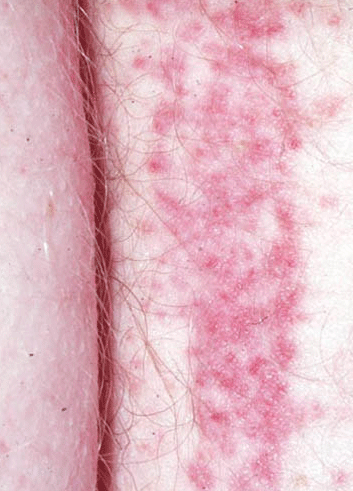- What is Henoch-Schonlein purpura
- Statistics on Henoch-Schonlein purpura
- Risk Factors for Henoch-Schonlein purpura
- Progression of Henoch-Schonlein purpura
- Symptoms of Henoch-Schonlein purpura
- Clinical Examination of Henoch-Schonlein purpura
- How is Henoch-Schonlein purpura Diagnosed?
- Prognosis of Henoch-Schonlein purpura
- How is Henoch-Schonlein purpura Treated?
- Henoch-Schonlein purpura References
What is Henoch-Schonlein purpura
Henoch-Schonlein purpura (HSP) otherwise known as anaphylactoid purpura is a blood vessel disease characterised by inflammation of the vessels, or vasculitis.
Inflammation of the blood vessels (vasculitis) is divided into different names and groups depending on which vessels that are affected. In HSP, the small arterial vessels that join the arteries and veins together are affected. These tiny vessels are called capillaries, and HSP affect these particularly in the skin and kidneys. Internally, the gut can be affected too as they are rich in capillaries.
Hence in HSP, 3 sites commonly involved are:
- skin
- kidneys
- intestines
Blood vessel vasculitis is evident in the image below:

Statistics on Henoch-Schonlein purpura
HSP is an uncommon disease. In a review from UK, the annual cases were about 20 per 100,000 children. However, data in US suggested the cases amount to 14 per 100,000 population of children aged 2-14 years.
Risk Factors for Henoch-Schonlein purpura
HSP is predominantly a disease of the children, where most patients (about 75%) are children aged less than 14 years old. The average age of onset is 4-5 years old.
HSP occurs more commonly in young boy compared to girls.
Because HSP commonly occurs after an common cold (see natural history), HSP occurs more commonly in spring, fall and winter months due to the increasing frequency of common cold or ‘flu’.
Progression of Henoch-Schonlein purpura
The exact mechanism of HSP is unknown. However the presumed mechanism for HSP is immune-complex deposition in the skin, where the body’s immune system is activated.
By an unknown substance, the immune complexes form in the blood stream. Immune complexes are a term used when the antibody in the blood binds to a substance. In normal situation, the substances would be the ‘bugs’ in which the body try to get rid of. However in HSP, the substance remains unknown. These immune complexes will get deposited in various tissues such as kidneys and blood vessels. The end result would be bleeding through the blood vessels leading to bruises over the skin.
The exact substance that started the whole chain of reaction remains elusive. Given that many of the HSP cases in children are preceded by common cold or ‘flu’, infective agents have been suspected to be the trigger to the events.
Other substances that induce the complex formation include:
- drugs
- foods
- insect bites
- immunization (vaccination)
How is Henoch-Schonlein purpura Diagnosed?
Routine laboratory investigations will be needed for patients with HSP. This is needed to assess the severity of the disease and also as a baseline for treatment effectiveness. These include tests to assess the function of blood system, kidney function and liver function.
Prognosis of Henoch-Schonlein purpura
HSP has an excellent prognosis where death rate is exceedingly rare. Most morbidity and mortality result from kidney involvement, ie. glomerulonephritis and/or acute and chronic renal failure, however this is an uncommon complication.
How is Henoch-Schonlein purpura Treated?
Because the disease is mostly self-limiting and prognosis is excellent (see prognosis), generally treatment involves ‘watchful waiting’ and steroid control of symptoms. Sometimes treatment may not be needed at all.
The treatment for adults and children is the same. If steroid therapy is needed, it will be given short term and then the dose adjusted according to the clinical course.
For more severe disease with significant kidney involvement, referral to specialist will be needed. Treatment options may include kidney transplant for the patient.
Henoch-Schonlein purpura References
- eMedicine: Henoch-Schonlein purpura [online]. 2004. [Cited 2005 October 12th].
Available from: URL: http://www.emedicine.com/derm/topic177.htm - Kasper D, et al. Harrison’s Principles of Internal Medicine. 16th ed. New York: McGraw-Hill; 2005.
- Kumar V, et al. Robbins and Cotran Pathologic Basis of Disease. 7th ed. New York: WB Saunders Company; 2004.
- Up to Date: Henoch-Schonlein purpura [online]. 2005. [Cited 2005 October 12th]. Available from: URL: http://www.utdol.com/application/topic.asp?file=glomrdis/6696&type=A&selectedTitle=1~27
All content and media on the HealthEngine Blog is created and published online for informational purposes only. It is not intended to be a substitute for professional medical advice and should not be relied on as health or personal advice. Always seek the guidance of your doctor or other qualified health professional with any questions you may have regarding your health or a medical condition. Never disregard the advice of a medical professional, or delay in seeking it because of something you have read on this Website. If you think you may have a medical emergency, call your doctor, go to the nearest hospital emergency department, or call the emergency services immediately.







